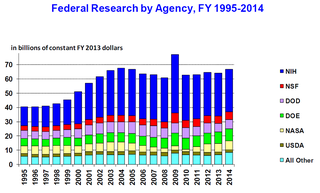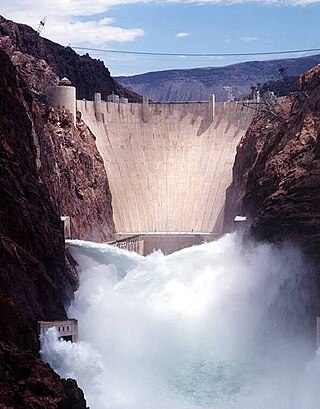
The Office of Management and Budget (OMB) is the largest office within the Executive Office of the President of the United States (EOP). OMB's most prominent function is to produce the president's budget, but it also examines agency programs, policies, and procedures to see whether they comply with the president's policies and coordinates inter-agency policy initiatives.

Pacific Northwest National Laboratory (PNNL) is one of the United States Department of Energy national laboratories, managed by the Department of Energy's (DOE) Office of Science. The main campus of the laboratory is in Richland, Washington.

Christine Gregoire is an American politician who served as the 22nd governor of Washington from 2005 to 2013. A member of the Democratic Party, she defeated Republican candidate Dino Rossi in 2004, and again in 2008. She is the second female governor of Washington. Gregoire chaired the National Governors Association for the 2010–2011 term. She also served on the Governors' Council of the Bipartisan Policy Center in Washington, D.C.
The Information Technology Management Reform Act of 1996 is a United States federal law, designed to improve the way the federal government acquires, uses and disposes information technology (IT). It was passed as Division E of the National Defense Authorization Act for Fiscal Year 1996. Together with the Federal Acquisition Reform Act of 1996, it is known as the Clinger–Cohen Act.

The Washington State Department of Ecology is the state of Washington's environmental regulatory agency. Created in February 1970, it was the first environmental regulation agency in the U.S. predating the creation of the Environmental Protection Agency (EPA) by several months.
The Puget Sound Regional Council (PSRC) is a metropolitan planning organization that develops policies and makes decisions about transportation planning, economic development, and growth management throughout the four-county Seattle metropolitan area surrounding Puget Sound. It is a forum for cities, towns, counties, transit agencies, port districts, Native American tribes, and state agencies to address regional issues.

The Washington State Legislative Youth Advisory Council (LYAC) is the official nonpartisan youth advisory body to the Washington State Legislature on issues related to young people in Washington. Created in July 2005, it consists of approximately 22 members, each serving a two-year term. According to state law, the mission of LYAC is to "examine issues of importance to youth, including but not limited to education, employment, strategies to increase youth participation in state and municipal government, safe environments for youth, substance abuse, emotional and physical health, foster care, poverty, homelessness, and youth access to services on a statewide and municipal basis."
Energy Savings Performance Contracts (ESPCs), also known as Energy Performance Contracts, are an alternative financing mechanism authorized by the United States Congress designed to accelerate investment in cost effective energy conservation measures in existing Federal buildings. ESPCs allow Federal agencies to accomplish energy savings projects without up-front capital costs and without special Congressional appropriations. The Energy Policy Act of 1992 authorized Federal agencies to use private sector financing to implement energy conservation methods and energy efficiency technologies.
The Guaranteed Education Tuition Program, or GET Program, is one of two 529 college savings plans administered by Washington College Savings Plans (WA529). WA529 is part of Washington Student Achievement Council, an agency of the U.S. state of Washington for residents of the state. GET is a 529 prepaid tuition savings plan, while Washington's other plan, DreamAhead, is a 529 college investment plan. As with any 529 plan, account owners invest in the program on behalf of a beneficiary – typically the owner's child or grandchild – in order to prepay for expenses associated with the beneficiary attending a higher education institution.
ARPA-E, or Advanced Research Projects Agency–Energy is a United States government agency tasked with promoting and funding research and development of advanced energy technologies. It is modeled after the Defense Advanced Research Projects Agency (DARPA).

The United States Department of Energy's State Energy Program (SEP) provides grants to states and directs funding to state energy offices from technology programs in Office of Energy Efficiency and Renewable Energy. States use grants to address their energy priorities and program funding to adopt emerging renewable energy and energy efficiency technologies. Started in 2010, the program "is the only program administered by the U.S. Department of Energy (DOE) that provides cost-shared resources directly to the states for allocation by the governor-designated State Energy Office for use in energy efficiency and clean energy innovation, development, and demonstration activities.”
The American Council for an Energy-Efficient Economy (ACEEE) is a nonprofit, 501(c)(3) organization. Founded in 1980, ACEEE's mission is to act as a catalyst to advance energy efficiency policies, programs, technologies, investments, and behaviors in order to help achieve greater economic prosperity, and environmental protection.
The Office of Electricity (OE) is a program office within the United States Department of Energy. The mission of OE is to work "closely with [...] private and public partners" and "lead the Department’s efforts to ensure that the Nation’s most critical energy infrastructure is secure and resilient." It does this through research and development of new technologies and overseeing the Federal and state electricity policies and programs for planning and market operations.
The Department of Archaeology and Historic Preservation (DAHP) is an independent government agency in Washington state which serves several functions, including regulatory functions. The agency inventories and regulates archaeological sites; houses Washington's State Historic Preservation Officer, State Archaeologist, State Architectural Historian and State Physical Anthropologist; maintains the Washington Heritage Register and Heritage Barn Register; provides expertise on environmental impacts to cultural resources; administers historic preservation grants for heritage barns and historic county courthouses; encourages historic preservation through local governments; provides technical assistance for historic rehabilitation and using historic preservation tax credits; and maintains extensive GIS databases to catalog the state's historic and prehistoric cultural resources.

The science policy of the United States is the responsibility of many organizations throughout the federal government. Much of the large-scale policy is made through the legislative budget process of enacting the yearly federal budget, although there are other legislative issues that directly involve science, such as energy policy, climate change, and stem cell research. Further decisions are made by the various federal agencies which spend the funds allocated by Congress, either on in-house research or by granting funds to outside organizations and researchers.

Hydropower policy in the United States includes all the laws, rules, regulations, programs and agencies that govern the national hydroelectric industry. Federal policy concerning waterpower developed over considerable time before the advent of electricity, and at times, has changed considerably, as water uses, available scientific technologies and considerations developed to the present day; over this period the priority of different, pre-existing and competing uses for water, flowing water and its energy, as well as for the water itself and competing available sources of energy have changed. Increased population and commercial demands spurred this developmental growth and many of the changes since, and these affect the technology's use today.
Smart grid policy in the United States refers to legislation and other governmental orders influencing the development of smart grids in the United States.

The Energy Savings and Industrial Competitiveness Act of 2013 is a bill that was introduced into the United States Senate during the 113th United States Congress. The overall purpose of the bill was to reduce energy waste by increasing energy efficiency in the United States. Among its many provisions, the bill includes measures to improve building codes, assist manufactures in becoming more energy efficient, and increase conservation efforts at federal agencies.

The Streamlining Energy Efficiency for Schools Act of 2014 is a bill that would require the United States Department of Energy to establish a centralized clearinghouse to disseminate information on federal programs, incentives, and mechanisms for financing energy-efficient retrofits and upgrades at schools. The bill would require the DOE to collect the data from all federal agencies and store it in one place online.








